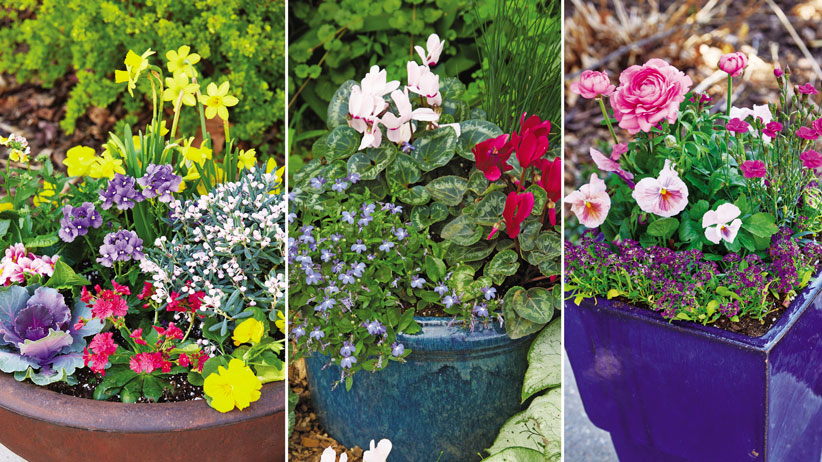Best perennials for a low-maintenance garden
If you’re a new gardener, you’re in for a great adventure! But with so many perennials to choose from, it’s hard to know which ones are best. Don’t worry. Keep reading and you’ll find 15 easy perennials, like these heliopsis and phlox, that are great choices for new gardeners.
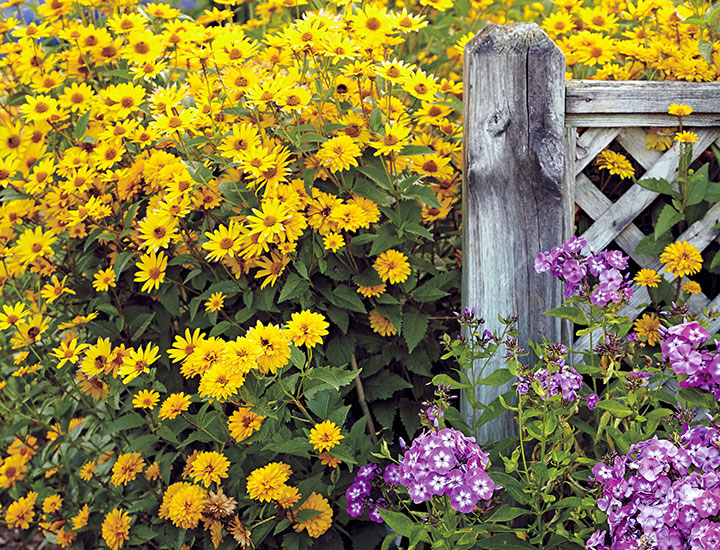
What makes an easy-care perennial?
These perennials tolerate a range of growing situations and take most weather conditions in stride. While nothing is completely pest- or disease-free, this group has fewer problems than some other perennials. And most are quite long-lived, too, so you can enjoy their flowers or foliage for years to come. If you're new to gardening, these characteristics will increase your success and help you enjoy great-looking perennials more quickly.
You Might Also Like:
Start a New Garden Bed the Easy Way
Long-Lived Perennials
How to Plant Perennials
Best perennials to plant in sunny spots
This group of perennials needs 6 to 8 hours of sunlight each day to look their best.

Heliopsis Heliopsis helianthoides
Native to eastern and midwestern North America, heliopsis is a great perennial for new gardeners. It grows 1 to 6 ft. tall. Yellow 2-in. flowers last for a couple of weeks in summer and have plenty of blooms. There are several heliopsis cultivars that all require the same growing conditions and care. Some are different sizes, some have semidouble or double blooms, and a couple even have variegated foliage. You’ll be able to cut a handful for bouquets without missing them in the garden.
As seedheads form, the neighborhood birds swoop in to grab a quick snack. Any that escape their hungry beaks and fall to the ground will usually sprout the following spring.
Growing tip
Although many reseed, they don't all come true, which means that the flowers and plants may or may not retain the same characteristics of the original plant. If you want more of a specific heliopsis cultivar, you’ll need to buy more or divide the plant that you have in spring.
Blooms Yellow semidouble or double blooms in summer Light Full to part shade Soil Moist, well-drained Size 1 to 6 ft. tall and wide Hardiness Cold hardy in USDA zones 3 to 9

Garden phlox Phlox paniculata
Garden phlox is a long-time garden favorite and for good reason. Big flower clusters top off stems that can be long or short, depending on the cultivar. You won’t miss out on summer color when you choose garden phlox. Plants bloom for 8 to 10 weeks in white, pink, red, magenta, lavender or purple.
Growing tips
-
To be sure you have the most flowers make sure plants get plenty of sun. They’ll grow in part shade but won’t flower as well and will develop weak stems. Many garden phlox lose their lower leaves as the season progresses. A disguise of lower-growing perennials or an ornament in front is usually sufficient to keep things looking good.
-
Powdery mildew, a fungal disease that affects the foliage, can be a problem for many garden phlox. It usually looks like a fine white or gray powdery coating. Growing resistant cultivars, such as purple and white ‘Laura’, white ‘David’, pink ‘Blushing Shortwood’ and Flame® Purple, Volcano® Ruby, above, helps keep powdery mildew from spoiling your beautiful garden view.
Blooms Pink, red, magenta, lavender, purple or white in summer to fall Light Full sun Soil Moist, well-drained Size 1 to 4 ft. tall, 1 to 3 ft. wide Hardiness Cold hardy in USDA zones 3 to 9
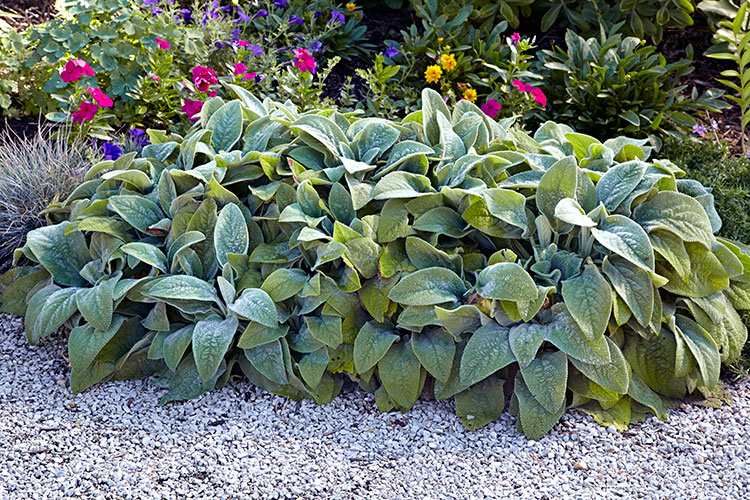
Lamb’s ear Stachys byzantina
Who could resist reaching out and touching the velvety leaves of lamb’s ear? Its low-growing stature makes it one of the best perennials for edging a sunny border.
Lamb’s ear likes plenty of sun and is very drought tolerant, which makes it easy to grow. Good drainage is the key to healthy, long-lived plants. Too much moisture from slow-draining soil or lots of overhead watering makes it hard for the downy leaves to dry out, so leaves rot. Lamb’s ear sends up spikes of lavender flowers in spring. If foliage is your focus, go ahead and deadhead or try ‘Big Ears’ above. Besides having larger leaves than the species, it doesn’t produce flowers.
Blooms Lavender or magenta in late spring Light Full sun Soil Well drained Size 8 to 12 in. tall, 12 to 18 in. wide Hardiness Cold hardy in USDA zones 4 to 8
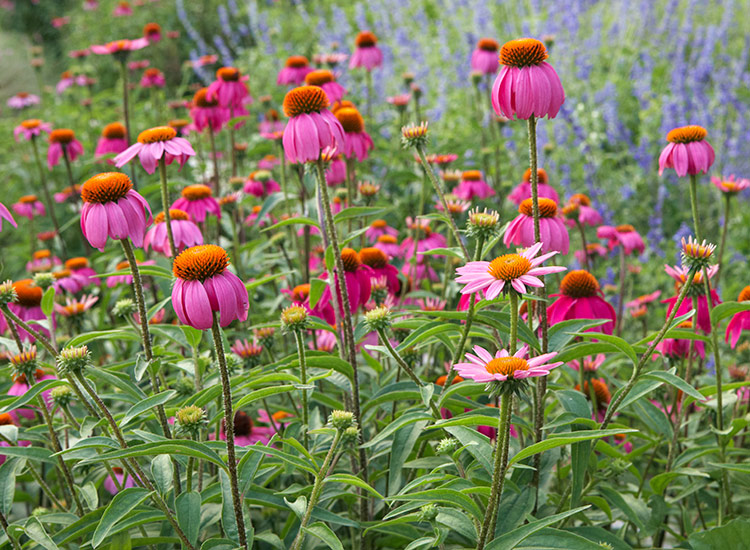
Purple coneflower Echinacea purpurea
You don’t need a prairie to grow this native of the Plains. Its easy-going care needs make it one of the best perennial border companions. Pretty purple-pink flowers bloom through the summer. Or choose from a range of colors—red, white, orange yellow, green — if you buy one of the many hybrids. Full sun will ensure you have plenty of blooms, but some afternoon shade helps keep flower colors from fading. Watch for aster yellows disease, which causes deformed leaves and flowers.
Growing tip
You can deadhead coneflowers to keep things tidy, but once the petals fall off, their distinctive center cones are a popular snack for goldfinches, cardinals and other seed-loving birds. So don't cut off all the flowers!
Blooms Purple-pink flowers in summer Light Full sun to part shade Soil Well-drained Size 24 to 36 in. tall, 18 to 24 in. wide Hardiness Cold hardy in USDA zones 3 to 9
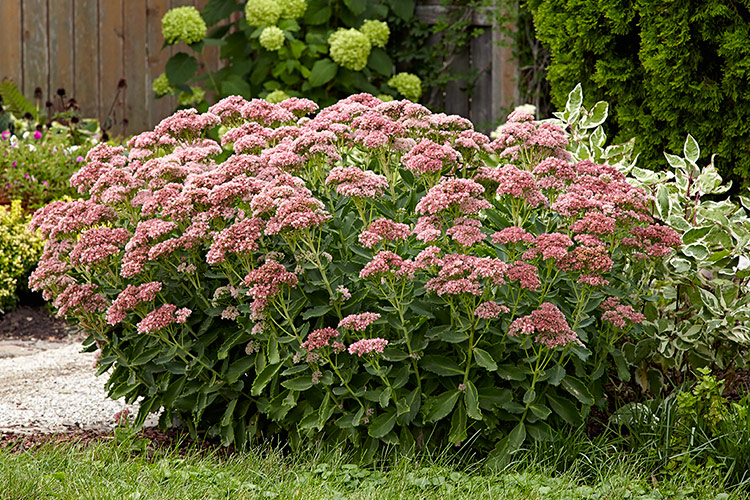
Tall sedum Hylotelephium spp. & hybrids
Tall sedum gives you a lot of bang for your buck. With minimal effort you get a good-looking plant from spring through winter — perfect for new gardeners. It comes in a range of sizes, foliage and flower colors but they all have one thing in common — bees and butterflies love them! Most tall sedums have green foliage, but some are variegated and others, such as ‘Chocolate Drop’, even have deep brown foliage.
Growing tip
Those large flower heads can get heavy and sometimes tall sedums split in the center and the flowers flop by the time they bloom. You can help prevent this by cutting stems back by up to half once or twice in early to midsummer. This will cause more branching and sturdier (but shorter) stems that stand up better.
Blooms White, brown, pink, red or burgundy in late summer to fall Light Full sun Soil Well-drained Size 9 to 36 in. tall, 12 to 24 in. wide Hardiness Cold hardy in USDA zones 3 to 10
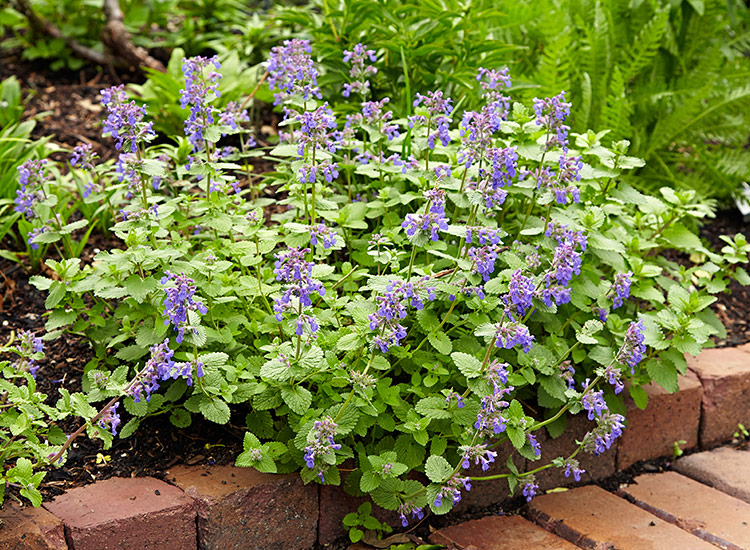
Catmint Nepeta x faassenii
Clouds of long-blooming catmint are so helpful. These mounding plants soften the sharp edges of hardscaping and cover the bare legs of taller plants behind them. Heat- and drought-tolerant, catmint is one tough plant. Because of its fragrant foliage, it's also one of the best perennials to grow if deer frequently mow your plants down. They don't seem to like the fuzzy, minty-smelling leaves. You may not want it next to the driveway or a path you walk frequently because while butterflies and hummingbirds love catmint flowers, so do bees.
Growing tip
As the flowers age, the plant often splays open, losing its tidy habit. You can cut the whole thing back to the ground and expect new foliage and flowers in a few weeks. Or grow a more compact cultivar, like ‘Cat’s Meow’.
Blooms Purple, blue, pink or white in late spring to summer Light Full sun Soil Well-drained Size 6 to 48 in. tall, 18 to 48 in. wide Hardiness Cold hardy in USDA zones 3 to 9

Hardy hibiscus Hibiscus moscheutos
Want some tropical flair where winters get below zero? Try hardy hibiscus. Its exotic-looking flowers get up to 12 in. across in pink, red, purple or white. While most have green foliage, Summerific® ‘Summer Storm’ above has deep purple leaves and 8- to 10-in.-wide pink blooms. To make sure the leaves remain purple, grow Summerific ‘Summer Storm’ in full sun. In part shade, leaves turn green. Some at the base of the plant may even turn because they’re shaded from above.
Did you know?
Though it looks like a shrub, hardy hibiscus is a perennial that dies to the ground every year and is usually one of the last to emerge in spring, so be patient.
Blooms Red, white, pink or purple in midsummer to fall Light Full sun to part shade Soil Moist well-drained Size 2 to 12 ft. tall, 2 to 4 ft. wide Hardiness Cold hardy in USDA zones 4 to 10
You Might Also Like:
How to Divide 45 Favorite Perennials
How to Divide New Perennials to Save Money
Perennial Deadheading Guide
7 best perennials for shade or part shade
This group of easy-care perennials will grow best with less than 6 hours of sun each day.
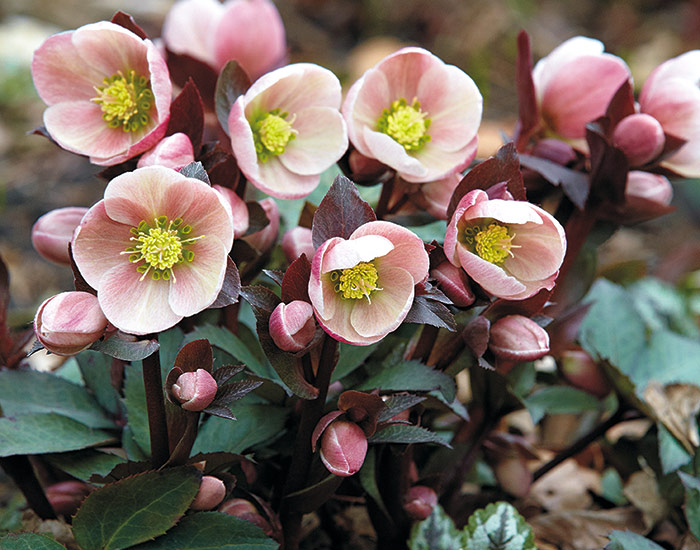
Hellebore Helleborus spp. and hybrids
Nothing gives a gardener hope like hellebores. Plants emerge in late winter to spring, depending on the species or cultivar, sometimes even poking through a layer of snow! Gold Collection® Pink Frost, above, is quite vigorous and has pretty pink flowers. This easy perennial is virtually pest free — deer don’t even bother it.
Growing tips
-
Hellebore leaves are evergreen and usually stay looking good in mild weather areas. But cold and wind take their toll where winters get below 0 degrees F. So if leaves look tattered, cut them to the ground before the flowers get going. That way you don’t have to worry about accidentally snipping flower stems off. You might want to wear gloves to protect your skin from the prickly foliage.
-
Don’t be surprised if you find a few hellebore seedlings in spring — they reseed very easily. Not all of them will look like the parent plants — leave them or pull them depending on the style of your garden.
Blooms White, pink, yellow, green or purple in late winter to early spring Light Part to full shade Soil Well-drained Size 1 to 3 ft. tall and wide Hardiness Cold hardy in USDA zones 4 to 9
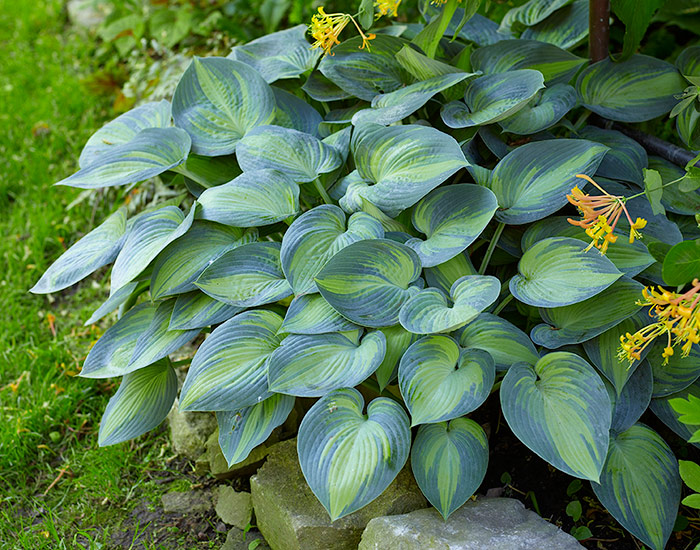
Hosta Hosta spp. and hybrids
Just about every gardener has grown a hosta or two. This might be the best perennial for new shade gardeners. There are thousands of cultivars, along with some species, and they come in colors and sizes to fit any garden. ‘June’ above is a popular choice because it’s so vigorous and has color-changing leaves. They start out with a blue edge and chartreuse center in spring. By summer, with some regular morning sun, the center turns more golden. Check out a gallery of our favorite hostas here!
Growing tip
If slugs are a problem look for cultivars like ‘June’ that have thicker leaves. These pests don’t find them quite as appealing as thinner leaves.
Blooms White, lavender or purple in spring to late summer are a favorite of hummingbirds Light Part to full shade Soil Moist, well-drained Size 3 to 72 in. tall, 6 to 72 in. wide Hardiness Cold hardy in USDA zones 3 to 9
Must-Have Tools for New Gardeners
Soil Knife
Watering Wand
Garden Pruners
Round-Point Shovel
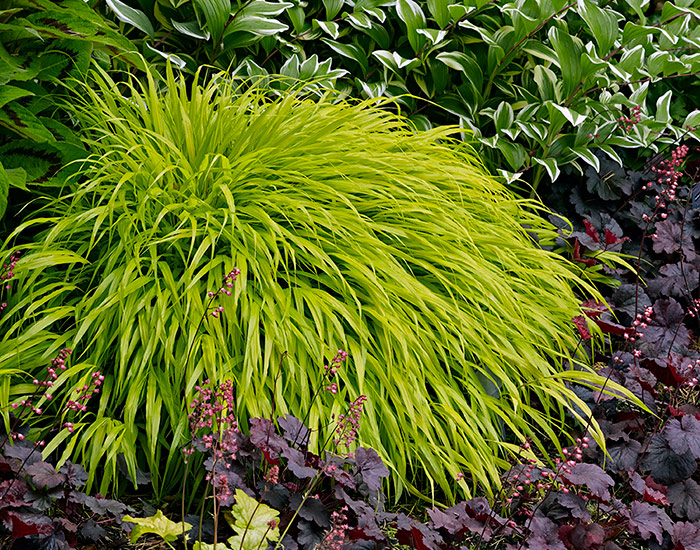
Hakonechloa Hakonechloa macra
There aren’t a lot of ornamental grasses that grow in the shade. But just a few hours of morning sun suits hakonechloa just fine. The species has plain green foliage but there are numerous cultivars with different variegations. ‘Aureola’ is yellow with narrow green stripes. The more light it has, the stronger the yellow becomes. With shade the green becomes more pronounced. In cool weather the leaves of ‘Aureola’ develop streaks of pink to red.
Growing tip
Hakonechloa is a slow grower that likes consistent moisture. Start off with a large plant — a gallon size or larger — and it will get established more quickly. In favorable conditions, hakonechloa spreads slowly by rhizomes and can even be used as a ground cover.
Blooms Yellow-green in late summer to fall Light Part to full shade Soil Moist, well-drained Size 1 to 2 ft. tall and wide Hardiness Cold hardy in USDA zones 5 to 9
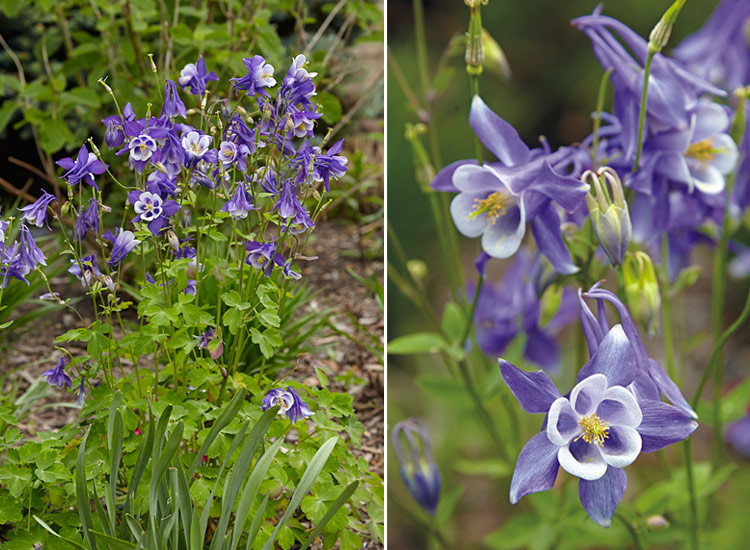
Columbine Aquilegia spp. and hybrids
Columbine may look like a charming, delicate plant but underneath those bobbing flowers is one of the best easy-to-grow perennials for new gardeners. This native and its cultivars have been known to grow in a sidewalk crack! Though most gardens offer a more hospitable environment than that, there’s no need to pamper columbine. Plants are quite drought-tolerant. Individual plants don’t usually live long — 3 to 4 years — but they often reseed. While wild columbine will come true from seed, or look like the parent plant, but hybrids, such as Songbird ‘Bunting’ above, won’t. Plants may die to the ground in summer but come back again next spring.
Blooms Pink, red, white, blue, purple, yellow or bicolor in spring Light Part shade Soil Well-drained Size 5 to 36 in. tall, 6 to 24 in. wide Hardiness Cold hardy in USDA zones 3 to 9
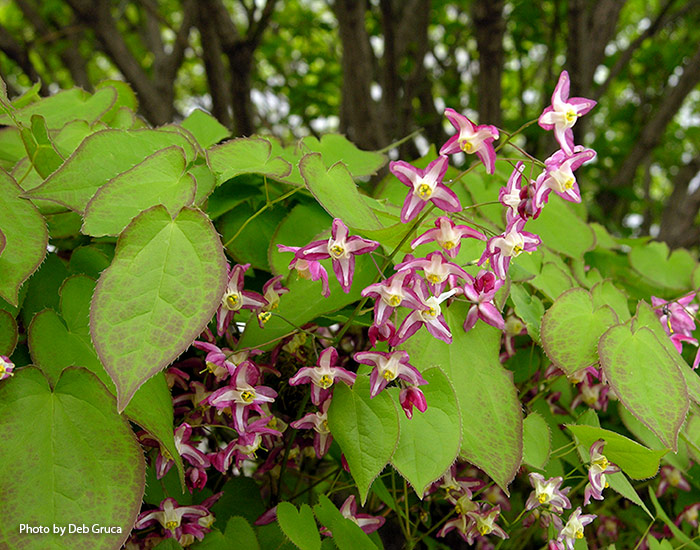
Epimedium Epimedium spp. and hybrids
Here’s a plant that won’t let new gardeners down. Though epimedium thrives in moist, well-drained soil, it can take dry shade with ease. There really aren’t any pests or diseases to worry about — deer and slugs don’t even bother it.
Small flowers in pale yellow, white, burgundy, red or pink pop up on long stems, before the foliage in spring. Epimediums are evergreen but the leaves can get pretty rough looking by the end of winter. Cut the old leaves off before the flowers start growing so you don’t snip off the tiny wirelike stems later.
Blooms Pale yellow, white, pink, red or burgundy in early spring Light Part to full shade Soil Well-drained Size 4 to 24 in. tall, spreading Hardiness Cold hardy in USDA zones 4 to 9
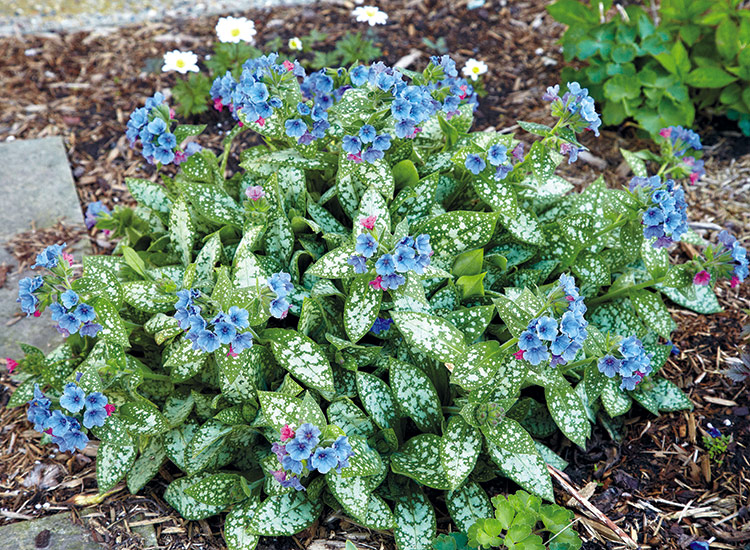
Pulmonaria Pulmonaria spp. and hybrids
Fuzzy, spotted leaves and pretty spring flowers are the calling card of this shade-loving beauty. Flowers put on quite a show, changing color as they age — usually a mix of pink, purple and blue. Or as ‘Trevi Fountain’ in the photo shows, pink to cobalt blue. Other cultivars stay a single hue of white, blue or pink.
Growing tip
To keep plants looking good, you’ll need to do a little housekeeping. As the flowers fade, plant stems start to sprawl open. Go ahead and cut them back to the ground to make way for fresh foliage. And if you notice some seedlings nearby, don’t be surprised.
Blooms Pink, purple. blue or white in spring Light Part to full shade Soil Moist well-drained Size 6 to 18 in. tall, 10 to 40 in. wide Hardiness Cold hardy in USDA zones 3 to 9

Old-fashioned bleeding heart Lamprocapnos spectabilis
The unique flowers and elegant arching stems of old-fashioned bleeding heart can’t be beat. Most types have pink and white flowers with green foliage but there are a few variations. ‘Valentine’ has red and white flowers, while ‘Gold Heart’ above has bright gold foliage. Care is easy for this perennial: Give old-fashioned bleeding heart regular water and a little compost — 1 to 2 in. — every year.
Plant pairing
In dry years, the foliage often dies to the ground, leaving an empty spot. Plants will grow back the following spring so put them near other perennials, such as hakonechloa, that spread out to cover the bare area.
Blooms Pink or red and white or white in spring Light Part to full shade Soil Moist, well-drained Size 24 to 36 in. tall, 15 to 24 in. wide Hardiness Cold hardy in USDA zones 3 to 8








